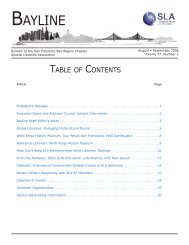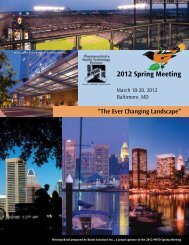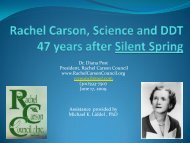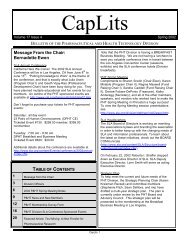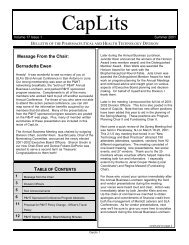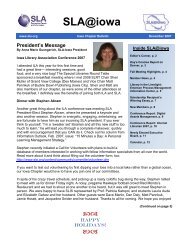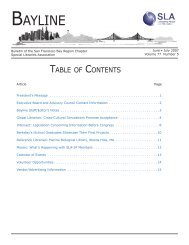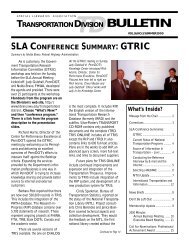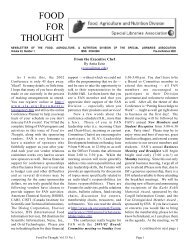Education Libraries - Special Libraries Association
Education Libraries - Special Libraries Association
Education Libraries - Special Libraries Association
You also want an ePaper? Increase the reach of your titles
YUMPU automatically turns print PDFs into web optimized ePapers that Google loves.
Actually, in the pure form<br />
of VTS we do not explore<br />
composition, medium or<br />
artist. Traditional aspects<br />
(formal elements) are not<br />
taught, and indeed, if<br />
students left an exhibition<br />
not knowing a single<br />
artist’s name, it is okay in<br />
VTS. Thus, teachers and<br />
librarians do not need a lot of background<br />
information to use this method.<br />
At the workshop I attended, you spoke of how<br />
students advance from being novice to more<br />
sophisticated viewers of art. What do you see<br />
and hear from them as they progress in their<br />
understanding of what they see? Can you give<br />
some examples?<br />
As students progress they use more sophisticated<br />
vocabulary, more creative terms to describe things<br />
like color, and start to come up with unusual and<br />
complex interpretations. One student I had in the<br />
museum described a sky as pumpkin colored<br />
instead of just orange, and another made up a story<br />
that was happening off the edge of the painting—<br />
the approach of a bear to the figure in the center.<br />
Also when students become more sophisticated<br />
they begin to ask deeper questions about the work.<br />
Considering how open-ended the inquiry<br />
method seems to be, is it possible that viewers<br />
can have a “wrong” interpretation? Can any<br />
understanding of an artwork be truly<br />
“wrong?”<br />
It’s not true that there are<br />
no “wrong” answers—the<br />
tree is green or the sky is<br />
orange—but in general,<br />
VTS accepts all answers if<br />
the viewer can ground it in<br />
the evidence of the<br />
painting. If the observation<br />
is still off-base, I ask the<br />
group if they see what the<br />
other viewer sees. I let<br />
them work it out. But in<br />
. The idea of visual literacy has<br />
become important currently because<br />
we are so bombarded with imagery<br />
every waking moment.<br />
It is important to become visually<br />
literate, or visually discerning, in<br />
order to survive.<br />
general, the understanding of<br />
an artwork as right or wrong<br />
is something that gets hung up<br />
in art historical discussions,<br />
not in VTS discussions.<br />
To some extent I suppose<br />
that focus on art and visual<br />
thinking is often secondary<br />
to students who are out to<br />
get a degree to get a job. How would you say<br />
the skills of visual thinking enhance the<br />
learning process as well as our ability to move<br />
through the world?<br />
VTS develops both critical and creative thinking<br />
skills which are essential to the learning process<br />
and applicable in all situations that involve<br />
ambiguous material. I also teach this to medical<br />
students to help them develop their diagnostic<br />
skills. I hope what I teach allows my students to<br />
see the artwork differently both visually and<br />
intellectually, and that they take this new ability<br />
out to see the world differently as well.<br />
Most of my questions to you have focused on<br />
art, but I believe what we’re talking about here<br />
is part of the broader scope of information and<br />
digital literacy. Where do you see the study of<br />
art in that continuum? How important is visual<br />
literacy really?<br />
Given that I love art; looking at and thinking about<br />
it, I see it as something that pervades all aspects of<br />
the contemplative life. Art is a reflection of<br />
society, of a people, of an<br />
individual. It is a pathway<br />
to the soul. It stimulates us<br />
to think, even for just a<br />
few minutes, in a new<br />
way, and in that sense,<br />
open new pathways in the<br />
mind. There is an<br />
information aspect to it,<br />
which is interesting, but<br />
that is not central. It is<br />
about the experience,<br />
either sensual or rational,<br />
and whatever message we might gain from it. The<br />
idea of visual literacy has become important<br />
<strong>Education</strong> <strong>Libraries</strong>, Volume 31, No. 2, Winter 2008 41



